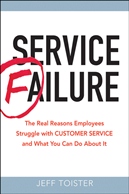Social media experiment: three strategies emerging
 Jeff Toister
Jeff Toister  Wednesday, March 17, 2010 at 10:45AM |
Wednesday, March 17, 2010 at 10:45AM |  My social media experiment is certainly getting interesting and three different Facebook strategies are emerging. The quick re-cap is I'm interacting with 12 companies via Facebook and Twitter to see how they try to engage me through these social media outlets. (It was originally 11 companies, but I called an audible and added a 12th.) Read more about the experiment here.
My social media experiment is certainly getting interesting and three different Facebook strategies are emerging. The quick re-cap is I'm interacting with 12 companies via Facebook and Twitter to see how they try to engage me through these social media outlets. (It was originally 11 companies, but I called an audible and added a 12th.) Read more about the experiment here.
Tthe three strategies are sell, tell, and engage plus a bonus strategy I call 'having no strategy'. I'm also revealing a few participants as examples.
Strategy #1: Sell
The most common social media strategy in this experiment is heavy on the media and light on the social. Companies often use Facebook and Twitter to 'meet customers where they are' and deliver promotional messages. This strategy doesn't take much effort, but it might provide the least return. Some companies in my experiment are just blasting promotion after promotion while refusing to interact with customers who comment on their Facebook pages or reply to their tweets. Others are doing a relatively good job of interacting with people who interact with them. I haven't made a purchase as result of a promotion from one of the participants in my experiment... yet.
Strategy #2: Tell
Some companies are using social media to provide useful information about their products or services. Cuvaison, a Napa Valley winery that makes amazing wine, posts You Tube videos to their Facebook page featuring their wine maker discussing various wines. I'm a member of their wine club and I thought it was cool to get a preview of my latest shipment before it arrived. I posted a comment asking when I could expect the shipment and someone from the winery quickly responded with an estimated arrival date. This strategy takes a little more effort than simply blasting sales pitches, but it can deepen your connection with your customers.
Strategy #3: Engage
Only a few companies are using social media primarily as a customer engagement tool. Best Buy is a tremendous example. My camera died after too many drops so I wanted to buy a new one. I posted a request for recommendations on Best Buy's Facebook page and received a quick response from Coral at Best Buy with a helpful link to product reviews along with two models she said were highly rated. Best Buy gets a lot of customer compliments and complaints on their Facebook page, and both get quick responses from a team of customer service reps. This strategy can lead to increased customer satisfaction, decreased customer complaints, and ultimately more loyalty, but it also takes the most time and money to execute.
Bonus Strategy: Having no strategy
Some companies have just put up a Facebook page and let the inmates run the asylum. Starbucks is a good example here. The really odd part is they have over 6 million fans, though I'm not sure why. (Perhaps I'm just not part of that demographic, whatever it is.) This strategy is by far the cheapest and easiest, but it strikes me as just doing something to follow the crowd. At the very least, companies following the 'no strategy' strategy should make it clear that their Facebook page is for fans to interact with each other and is not monitored by company representatives.







